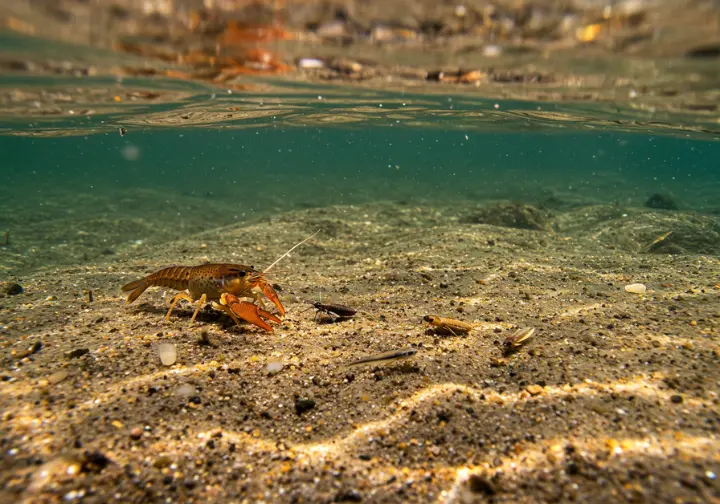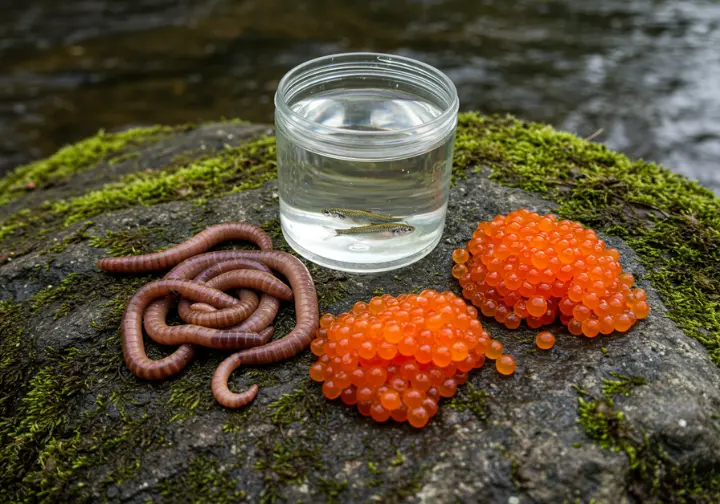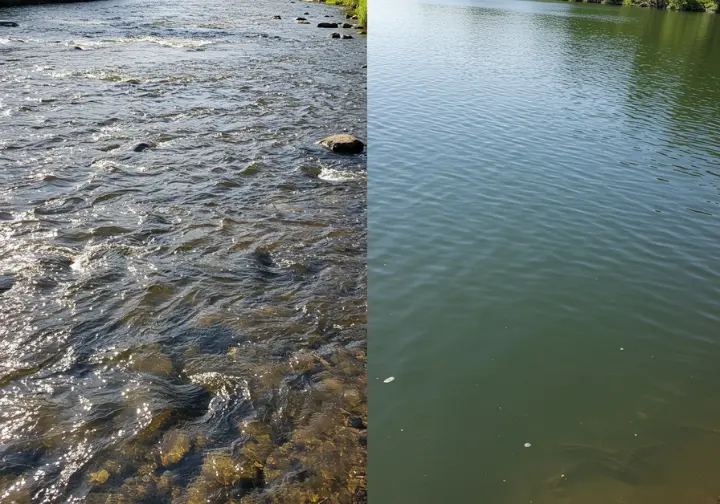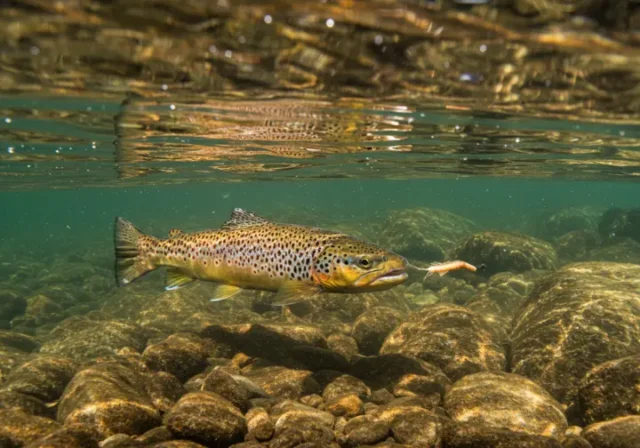In this article
To catch impressive brown trout, you need to match the hatch and think like they do! Terrestrials and nightcrawlers are excellent choices when selecting the best bait for brown trout. Use minnows effectively, mimicking their food and adjusting retrieve speed. Target big brown trout by upsizing your bait offerings and fishing after dark. Remember stealth. Using the right bait and tactics is crucial for success. Keep exploring to unlock the ultimate angling secrets for brown trout!
Understanding Brown Trout Diet

To pick your bait, you’ve gotta know what brown trout eat! We’re going to explore which factors influence their feeding patterns, focusing on common prey. It’s important to recall they’re opportunistic predators, so let’s unpack this. Browns often gravitate toward areas providing protection, so bait selection should mimic prey found in these zones.
Factors Influencing Feeding
Brown trout feeding is anything but predictable, and grasping what makes them tick can seriously up your angling game. You’ve gotta consider several factors. Water temperature’s a big one; it impacts their metabolism directly. The clarity of the water affects how they hunt, too. Clear water demands realistic baits and lures.
Where are you fishing—rivers or lakes? This dictates what baitfish might be available. Bear in mind, brown trout are opportunistic. They adapt, switching prey based on what’s around! Keep what they eat top of mind, and you’ll fool the wiliest trout. Matching the hatch is crucial in clear water to mimic local prey effectively.
Common Natural Prey Items
Grasping what brown trout eat is key to fooling those fish, and their diet’s pretty diverse. Aquatic insects are pivotal. We’ve all seen trout face into the current, snapping up mayflies. Then there’s the bait fish; bigger trout target minnows. If you’re after trophy fish, consider lures mimicking a fleeing bait fish or a wounded bait fish.
Don’t forget about crustaceans. Crawfish and shrimp are brown trout candy in many areas. Terrestrial insects that randomly fall in create a bonanza. And during salmonid spawns, drifting eggs are easy meals. Brown trout even eat small mammals. Knowing those insights helps you when trout fishing.
Many popular trout species love those food sources, even brook trout. That panicked bait imitation can propel them wild! Focus on oxygen-rich riffles where trout actively feed during insect hatches for the best results.
Opportunistic Predator Behavior
Since brown trout are fundamentally opportunistic predators, they’ll often eat whatever’s easiest to grab at the time. This is why they’re such effective predatory fish in the fishery and fisheries. You’ve got to present your fishing lures as an easy meal. Watch for spots where fish hide – behind rocks, in seams – and focus your bait drift there.
Low-light conditions are ideal for targeting brown trout, as they become more active and move into shallower waters.
Best Natural Bait Choices

You’re probably wondering what natural baits brown trout can’t resist. We’ll explore some top choices, starting with the ever-reliable earthworm. Fresh, high-quality bait is important for maximizing your catch rate. Finally, we’ll check out insects, minnows, and fish eggs to see how they can attract those trophy browns.
Earthworms: The Classic Choice
Earthworms—nightcrawlers, red worms, and garden worms—are must-haves since they’re a top-shelf natural bait for brown trout, imitating aquatic worms and insect larvae which trout naturally eat. They’re a go-to bait considering they mimic natural food—a solid advantage for trout fishing! For bigger brown trout in freshwater rivers, use larger nightcrawlers in deeper pools. Smaller red worms work wonders in streams for smaller freshwater fish.
You’ll want to rig ’em right. Thread your earthworms naturally on your hooks, sizes #8-12, to tease brown trout. A small split shot helps ’em sink. We’ve all seen worms drifting naturally with the current; this is what you’re imitating. Cast upstream and let your bait flow. Believe it–it works!
Expert guides will confirm garden worms are a top bait choice. Fishing with earthworms is classic and they get results. Catfish scavenge along the riverbed just like brown trout, making earthworms a versatile bait choice.
Minnows: Big Trout Magnets
If you’re hunting for trophy-sized brown trout, minnows are often an angler’s secret weapon. They are the best bait for brown trout as they imitate a primary food source. A big brown trout in freshwater can’t resist them!
You’ll want to match the size of the minnows to the local forage fish. Hook live minnows through the lips for natural swimming action or lightly through the back to mimic an injured fish. Experiment!
Drift them under a float, retrieve slowly, or still-fish them in deep holes in the river, lake, or creeks. Location matters! They’re a recommended bait option when chasing trophy brown trout. Minnows are big trout magnets. Handle them with care to keep them lively.
Fish Eggs: Seasonal Powerhouses
When brown trout are keyed into spawning behavior, fish eggs emerge as seasonal dynamos in your tackle arsenal. You’ll find these baits are absolute difference-makers! Fish eggs, like salmon or trout eggs, provide brown trout with a high-protein, easy snack. Their bright colors act like a visual dinner bell, ringing the trout to feed.
Focus your fishing downstream of spawning grounds, where eggs naturally tumble. You’ll want to pay attention to fall during salmon and brown trout spawning. When fishing, drifting, and using light fishing lines are key. Anglers often use small hooks (#8 – #14) and egg loop knots.
Smaller hooks maintain bait liveliness while improving hookup rates. Spawn netting helps create durable fish eggs bait sacks for casting. If natural fish eggs are restricted, artificial lures can work too and they can too be used in ponds.
Insects and Other Critters
Beyond the allure of fish eggs, you’ll discover how insects and other critters stand out as prime contenders in the natural bait arena. Crickets and grasshoppers make excellent bait when you’re brown trout fishing. They’re killer fished on the surface near the shore. Aquatic insect larvae, such as hellgrammites, are superb, especially in rivers. Drift them near the bottom; large brown trout love ‘em.
Don’t overlook wax worms; they’re great, too. Leeches? Absolutely! They’re beefy and drive the big guys wild. When using insects for deep water fishing, match the local fauna. Observe what’s in the water! For the best results, target swirling eddies where food naturally gathers and trout are likely feeding.
Selecting Artificial Lure Winners

You’re ready to ditch the real stuff, right? We’ll explore proven artificials like spinners, spoons, and plugs to fool even smart trout. Now, we dig into what makes ’em winners! For trout that are keyed in on specific insect hatches, try matching your fly selection to the active prey.
Spinners: Flash and Vibration
Spinners are great artificial lures for brown trout as the flash and vibration from their spinning blade looks like a small baitfish trying to get away, which makes trout want to eat them. These effective lures today mimic a small fleeing baitfish. You’ll find that selecting the right size spinner is crucial; it’s about matching the prevalent baitfish.
You can cast upstream or across the current and retrieve it just fast enough to keep the blade spinning. Vary your retrieval speed. Blade color matters a lot, too. Silver is reliable for sunny days, and gold is better for cloudy days. Spinners often work, but guarantee your swivel spins freely. A damaged lure won’t work. Adjusting your trolling speed can further enhance spinner effectiveness by mimicking natural baitfish movements.
Spoons: Mimicking Injured Prey
If you want to mimic an injured or disoriented baitfish, spoons, such as the Kastmaster, Little Cleo, or Krocodile Spoon, are classic trout lures designed to wobble and flash erratically on the retrieve, creating them an easy target for predatory brown trout. It’s a straightforward fish imitation that works.
For effective lure selection, think about where you’re fishing. Heavier spoon lure work wonders in deep lake water or strong current; lighter ones are your go-to in shallow streams. Adjust your retrieve: vary speeds, add pauses. It’ll create this injured prey seem real. Colors matter, too. Silver for clear days, gold for murky conditions. The appropriate lure and technique can truly be a game changer in enticing those cunning brown trout.
Plugs: Realistic Minnow Imitations
When brown trout are hunting, minnow-imitating plugs, which include jerkbaits and crankbaits, can be your ticket to success, particularly if you’re after the larger fish in the river. These lures are awesome as they mimic baitfish, a minnow, really well. You can’t go wrong with trout-patterned lures, but sometimes brighter colors work too, depending on water clarity.
With jerkbaits, think about how a wounded minnow acts. Use this jerk bait to twitch and pause it. You’ll get those reaction strikes from brown trout. Crankbaits plunge to specific depths, so you can get your lure right where the fish are. If it’s a standard jerk bait or jointed lures imitating fleeing crawfish, get ready for some action. We’ve all held our breath when the line twitches—it’s game on!
Lure Selection Factors
Since you’re trying to catch this monster brown, selecting the right lure is more than just tossing something shiny into the water but rather a skill. You gotta consider everything to find that perfect lure! Size matters. A small profile bait works wonders when they are timid fish or hitting small insects. But, if you’re hunting a trophy, go bigger.
Think about water clarity, too. Adjust the brown trout color you’re using. In clear water, natural colors rock. Murky water? Go brighter! Don’t forget action. How the bait moves can make or break your day. Maybe a crank bait, little crankbait, little spinner bait or jerk baits will get them going? If one thing isn’t working, change things up. That last lure you try could be the winner.
Adapting Your Bait Strategy

You’ve got your go-to baits, but are you really set for anything? You’ll need to tweak your strategy depending on regardless you’re hitting rivers, lakes, or facing changing water conditions and seasons. How about we investigate how to adapt and keep those browns biting.
River Fishing Considerations
Rivers and streams present unique challenges and opportunities, so you’ve got to adapt your bait strategy to be successful. For elusive brown trout, you’ve got to think small water fishing and target creeks. When fishing cooler water rivers, recall trout hold behind boulders and in undercut banks. You’ll need light fishing lines as stealth is key.
Consider your time of day. If you want to bait overnight, this is fine, but active fish are always ready to eat. Might bait can be effective, but natural presentation is crucial. Cast upstream, letting your bait drift naturally. For lures like a rooster tail, cast across and retrieve downstream. Recall, matching the hatch improves your odds.
Lake Fishing Approaches
To hook brown trout in lakes and reservoirs, you’ll want to key in on structure, depth changes, and food sources. Fish hold near weed beds, drop-offs, rocky points and submerged timber. For covering water, consider trolling with spoons, plugs or rigged minnows. Downriggers will help!
If you’re casting from a boat or shore, target docks, fallen trees, or weed lines with jerkbaits and spinners. Recall, it’s not just about trout fishing kit; some use similar approaches for bass. Fishing fresh lakes offers multi-species fishing opportunities, maybe even salmon. Jigging, either from a boat or casting, works well when fish hold tight to the bottom. Don’t forget still-fishing with worms or minnows, especially when targeting White River brown trout. Using the right rod and reel makes it easier to reel in even big fish. Bait offshore might be your ticket.
Adjusting for Water Conditions
As conditions change, you’ll want to adapt your bait strategy to match what the trout are seeing and feeling. Water clarity is key. In clear water, you need natural patterns since hungry brown trout rely on sight; think silver and white. But if it’s murky water, you gotta switch to bright colors like gold or chartreuse that fish can actually see.
Water temperature additionally plays a big part. When it’s cold, slow down your retrieves. As it warms up, you can fish those go-to lures faster. If water levels are high, they force the fish in the direction of the banks. In low water, trout are wary. Weather patterns impact everything, too. Overcast days can get them feeding more aggressively. Adjust, adapt, and you’ll get those fish reeled in!
Seasonal Bait Adjustments
Since brown trout behavior changes with the seasons, you’ll want to adapt your bait and tactics to match. Spring means aggressive feeding. Think spinners, spoons, and worms around those rainbow trout spawning areas. Summer pushes ’em deeper; match those insect hatches or try worms and minnows in early mornings.
Fall sees pre-spawn aggression where minnows and streamers come into play. Check out theflyfishingblog.com for some killer patterns. Winter requires patience and slow presentations of jigs or minnows near the bottom.
Your rods and reels need to be dialed; a light rod tip can help detect those subtle winter bites. Consider trout slip floats for deeper presentations—some rental boats even come equipped. Bear in mind, adjusting your setup seasonally’s key.
Secrets for Landing Big Browns

Think you’re ready to snag a real monster? You’ll need to upsize those baits and sharpen your night fishing skills if you want to land a brown trout of epic proportions. Let’s unlock those secrets now, covering everything from timing your trophy hunt to perfecting the art of stealth and patience.
Upsizing Baits and Lures
Targeting big brown trout means you’ve got to up your bait game as these big boys are looking for a substantial meal. Think big minnows, plugs, and spoons. A perfect jerk bait will mimic larger bait fish whereas tempt those trophy browns. Don’t shy away from nice fish as they’re found preying on perch and small trout. A largemouth thinks a multi-species lure is quite a meal.
Fly anglers, streamers as look like sculpins or crayfish are your weapon of choice. When you’ve got your straight lures, you’ll be needing good treble hooks, for this reason make sure you’ve got multiple hooks as you’ll lose some through small water casting. And a good reel combo will help you retrieve what fish caught you. A sizable offering increases your odds of scoring whereas fish.
Mastering Night Fishing Techniques
When the sun dips, that is your cue: Night fishing is a killer move if you’re after massive brown trout since those usually cautious fish get way more active and a whole lot less careful once it gets dark. That means you’ve gotta be prepped, making sure you’re comfy fishing in the dark, and that means having a trusty headlamp.
You will find those big brown trout hang out in the shallows at night. Toss out some loud lures like dark-colored streamers or plugs those push a lot of water. Your presentation is key; you will want slower retrieves when it’s dark, so they can track those lures. The steady swing always works! Listen and feel for the strike. I know we’ve all pulled hooks, but we’re still finding ways to avoid doing it!. That isn’t some dark harbor secret, it’s just night fishing for brown trout done right.
Timing Your Trophy Hunt
Night fishing cracks open chances at those behemoth browns, but let’s crank the lens and look at a bigger picture: timing. You’ve gotta comprehend when to hit the water. Fall’s pre-spawn means aggressive fish, making them likelier to crush your fish sticks. Early spring, they’re hungry after winter; think easy meals. Don’t neglect summer’s low-light periods for fun fish. Post-rain? Even better. Murkier water boosts confidence for big browns.
Understanding movement in your overall fishery is critical. What size reel are you planning on bringing? State fishing license is key. Consider surf fishing when conditions are right. Figuring out when they’re vulnerable? That’s your sure-catch solution. It’s understood Milwaukee Harbor holds promise. Nail your timing, and you’re halfway to a trophy. That isn’t just fishing; it’s a hunt.
Stealth and Patience Pays
Since big browns didn’t get to be big by being dumb, you’ve got to bring your A-game with stealth and patience if you’re serious about landing one. Large browns are wary, especially in clear water. We’ve all been there – one wrong move, and they’re gone. Approach spots slowly, keep low, and wear camo.
Lighter lines and long fluorocarbon leaders are key; you’re trying to fool cautious fish, after all. Patience is crucial; they don’t always feed. Work areas diligently, waiting for those low-light windows. Persistence pays off.
Make long casts; it’s your first impression. Position yourself to use the current. Before casting, observe. Look for activity, lies, natural food. A little observation prevents spooking them. Don’t forget, we’re not just fishing; we’re hunting.
Mastering Brown Trout Bait
Success hinges on comprehension the brown trout’s opportunistic yet often wary nature, and you’ve got to recognize how their diet is diverse. Browns eat insects, crustaceans, baitfish, even small mammals! Natural baits like worms and minnows are dynamite since they mimic what trout already eat. Make sure you’re presenting ’em naturally!
Artificial lures? Spinners and spoons work wonders. Match the size, color, and action to what’s happening in the water.
You’ve got to adapt. River or lake? Clear or murky water? Season? These things matter. If you’re after a trophy brown, think bigger baits, night fishing, and pre-spawn spots. Stealth is your friend.
Don’t get discouraged. Spookiness? Use lighter lines and ease up to your fishing spot. Can’t hook ’em? Experiment with different presentations until you find the technique that works. Keep observing, noting patterns, and refining. This is how you master the game.
Popular Questions
Can I Use Scented Attractants With Live Bait? +
What’s the Best Time of Day to Fish? +
How Do Weather Conditions Affect Bait Choice? +
What Knot Should I Use to Attach My Bait? +
Should I Use a Swivel With Live Bait Rigs? +
We are a participant in the Amazon Services LLC Associates Program, an affiliate advertising program designed to provide a means for sites to earn advertising fees by advertising and linking to Amazon.com. As an Amazon Associate I earn from qualifying purchases. We also participate in other affiliate programs. The information provided on this website is provided for entertainment purposes only. We make no representations or warranties of any kind, expressed or implied, about the completeness, accuracy, adequacy, legality, usefulness, reliability, suitability, or availability of the information, or about anything else. Any reliance you place on the information is therefore strictly at your own risk. Additional terms are found in the terms of service.









